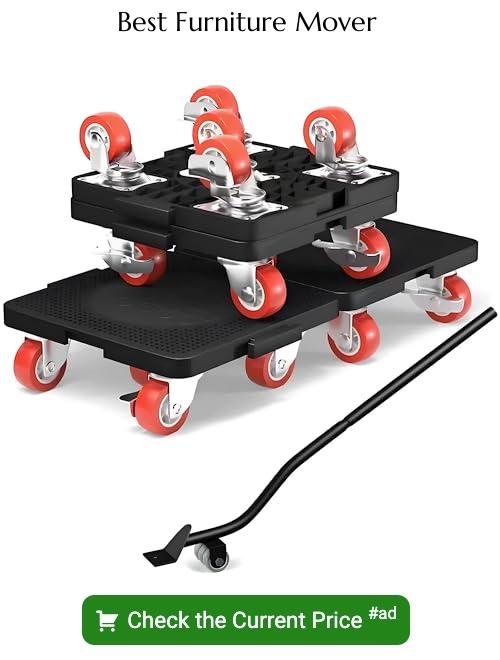Last updated on
In this step-by-step guide, you will learn how to securely and efficiently move your couch by yourself, minimizing the risk of damage or injury.
Key takeaways:
- Measure the couch dimensions before moving.
- Clear pathways and doorways of obstacles.
- Lift the couch using proper techniques to avoid injury.
- Navigate stairs and tight corners strategically.
- Secure the couch during transit to prevent damage.
Table of Contents
Assess the Couch Dimensions
Before undertaking the movement of a couch, measuring is a crucial step to ensure it will pass through hallways and doors without issue. Grab a tape measure and note the width, depth, and height. Compare these numbers to the width and height of your doorways, staircases, and hallways. Don’t forget to take into account any legs or parts that can be removed to reduce the couch’s size.
This preliminary step can save time and prevent potential damage to the couch and your home’s interior. If the couch appears too large for certain areas, consider alternate routes or disassembly options.
Clear Pathways and Doorways
Before attempting to move the couch, ensure all pathways are free of obstacles. Remove any items that could trip you, such as toys, rugs, or decor.
Measure doorways, elevator doors, and stairways to confirm the couch can fit through without scraping walls or jamming. Sometimes, removing a door from its hinges provides a few extra inches of clearance.
If your couch has removable legs or parts, disassemble them to reduce its overall size and make maneuvering easier.
Protect corners and sharp edges in narrow passages with padding to prevent damage during the move.
With a clear and measured route, the couch can be moved safely and smoothly to its new location.
Lift Using Proper Techniques
When lifting any heavy furniture, including a couch, engage your legs, not your back. Squat down at the knees, keep your core tight, and lift with your leg muscles, rising smoothly to a standing position.
If the sofa is low, avoid bending at the waist and instead get down to the level of the couch. For sofas with legs, try to get a firm grip underneath the base or legs. When you grip the couch, your hands should be palm-side up (an underhand grip), as this position is stronger and less strenuous on your arms and back.
Keep the couch close to your body as you move, maintaining a straight posture without twisting your spine. If you must turn, pivot with your feet, not your torso, to prevent injury. Also, take short, deliberate steps to maintain balance and control, especially important when navigating through narrow hallways or door frames.
Remember, your safety is paramount, so if at any point the task feels overwhelming, consider seeking help to avoid personal injury or damage to the furniture.
Navigate Stairs and Tight Corners
Navigating stairs and maneuvering through tight corners can be tricky, but with strategic movements, the task becomes manageable.
First, if possible, stand the couch on its end to reduce its width, which makes it easier to fit through narrow spaces.
As you approach corners, pivot the couch by lifting one end and rotating it in the direction you need to go.
On stairs, it’s safest to move backward, pulling the couch up one step at a time, using the ‘high-low’ method.
Here, one person holds the higher end and the other takes the lower, leveraging the height difference to keep the couch angled and prevent it from becoming unwieldy.
Always keep the couch slightly tilted upwards against the direction you’re moving to maintain control and reduce the risk of the couch slipping or sliding.
Remember to take your time; haste can lead to damage or injury.
Secure the Couch During Transit
When preparing for transit, ensure the couch is immobilized to prevent damage. Use moving straps or ropes to secure the couch to the moving dolly, reducing the likelihood of it sliding off during transport.
If using a vehicle, such as a van or truck, position the couch against the side wall and use additional straps to anchor it to the vehicle’s built-in tie-down points.
For added protection, blanket padding can be wrapped around the couch to shield it from scratches and scuffs.
Check stability by giving the couch a gentle shake before hitting the road. If the vehicle’s movement causes the couch to wobble, tighten the straps accordingly to achieve a snug, stable fit.
FAQ
How do you move a couch through a door by yourself?
To move a couch through a door by yourself, it’s advisable to rotate, twist, and tilt the couch carefully, allowing it to slide out of the space, or if it’s a smaller sofa, it can be tilted and moved through the doorway in an upright position.
What are the precautionary measures to consider when moving a couch by yourself?
When moving a couch by yourself, ensure to remove all detachable parts, use proper lifting techniques, secure the moving path, employ sliders, and consider using furniture straps or a dolly to prevent injuries or damages.
How can you dismantle a couch for easier transportation?
To dismantle a couch for easier transportation, you need to remove the cushions, detach the legs using a screwdriver or wrench, and separate the sections of the couch if it’s a sectional.
How do you protect your couch from damage during the move?
To protect your couch during a move, wrap it thoroughly in furniture pads or bubble wrap and secure it with moving straps, placing it carefully on a furniture dolly for transportation.





